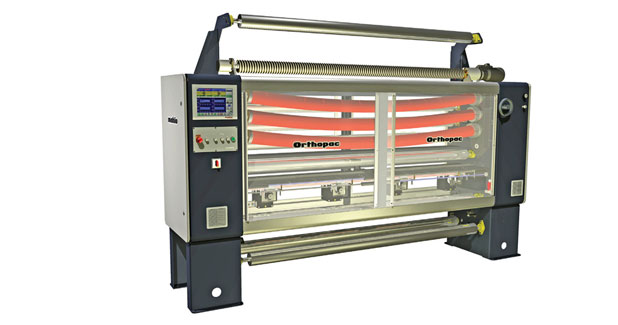
Mahlo: Birthplace of the weft straightener
The Orthopac RVMC was the first to combine the functionality of a weft straightener with that of a process control system in one compact device. On August 5, Mahlo GmbH + Co.KG celebrated its 72nd birthday.
The Orthopac RVMC was the first to combine the functionality of a weft straightener with that of a process control system in one compact device.
On August 5, Mahlo GmbH + Co.KG celebrated its 72nd birthday. Then, over seven decades earlier, nobody could have guessed the success the “Dr Eng Heinz Mahlo Electromechanical Workshops†would have some day. The development of the first automatic weft straightener put the company in the position of a global market leader and hidden champion. Today, Mahlo employs over 200 people and operates in more than 100 countries. When Dr Mahlo founded his Dr Eng. Heinz Mahlo Electromechanical Workshops right after World War II ended, he and his team started to build and repair radios. Dr Mahlo quickly changed the company’s course: in 1948, he developed and produced the first electrical moisture meter for the textile industry, named Textometer RMS. Demands from a steadily growing customer base led to further developments of measurement and control systems.
Global novelty weft straightener
The worldwide breakthrough for Mahlo, however, was achieved 10 years later with the patent for the first fully automatic weft straightener. Dr Mahlo named his revolutionary machine ‘Orthomat FMC’, introducing it for the first time at the leading textile fair ITMA in Milan in 1959. Every modern weft straightener today is still based on the principle of this system.
The Orthomat recognised the weft thread position, no matter which type of fabric, pattern or speed. Up until this point, the inability of the human eye to detect distortions in fast running webs had often limited textile production. But the weft control system does not only display drafts: it makes sure that the goods are produced weft-straight.
To detect the drafts, Mahlo used a combination of sensors (called scanning heads) and a light source, between which the product run. Arranged on a rack support, Orthomat FMC’s scanning heads captured the position of the weft thread photoelectricly at various points. They scanned the light of the headlamps that shines through the fabric and whose intensity was modulated by the weft threads’ position, processed it for the control technology and submitted a signal to the downstream straightening machine. Thus, the system worked with so-called transmitted light. Three easily seen instruments displayed bow-, skew- or overlaid distortion with bars. Skew distortions were righted with cylindrical rollers, bow distortions with curved ones. The principle was as easy as effective.
By correcting the rollers, the online cloth had to cover different distances from one side to the other. With that, the distortion got corrected. To compensate a skew distortion, either the left or the right edge of the cylindrical rollers was swayed further into the fabric.
To compensate a bow distortion, the middle of the bow rollers was altered and swayed further into the fabric. The same technique is applied today. Even in 1958, the Orthomat FMC controls the rollers in the stenter frame’s inlet autonomously, albeit the manual handling of the rollers was possible.
Ongoing developments
At the end of the 1950s, the electronic system was still run by electronic tubes – the same that were used for radios. In the 60s, transistors were the preferred format. Already in the 1970s those were replaced by integrated circuits. Mahlo used this system also for its next coup: In order to guarantee the best possible workflow between regulator and straightening machine, the manufacturer combined both systems in one machine. The Orthomat RFMC was born.
The principle was still the same, but again Mahlo created a novelty here. The Orthomat RFMC used for the first time oscillating scanning heads. This means that the cylindrical lens oscillates around its centre in an angle up to ± 45° when scanning the goods. If the lens is parallel to the weft thread, the signal modulation is the strongest. The more the direct axis of the lens wanders from the direction of the weft thread, the weaker is the modulation. The system analyses these changes and converts them in a distortion angle. The straightener uses this data to correct the distortion.
During the next machine generations, Mahlo focused on the development of the screening heads. The company regularly set new standards regarding speed, precision as well as data volume, and met upcoming challenges. With textiles that barely let any light through, a reflecting incident light supplements the proven transmitted light, for example. Used together, they ensure the best possible result. In addition to that, the manufacturer expanded its successful machinery by another system. The Orthopac RVMC was the first to combine the functionality of a weft straightener with that of a process control system in one compact device. Besides the draft, one could measure moisture, temperature, basis weight or width among other things.
Generation 15
In perfect timing for the company’s 70th anniversary, the new generation of weft straightener systems 15 was launched in 2015. The Orthopac RVMC-15 meets every challenge the modern textile industry has in store. Equipped with digital scanning and state-of-the-art processor technology, it adapts the control automatically to different textiles. In the process, Mahlo is steadily pushing the latest trends, for example the concept of Industry 4.0 – the vision of connected and interacting machines. The new generation of Mahlo straighteners, sensors and control circuits are arranged in a way that they can communicate not only with each other but also with alien systems. Thus, the user has access to his machines at any time and from everywhere.




